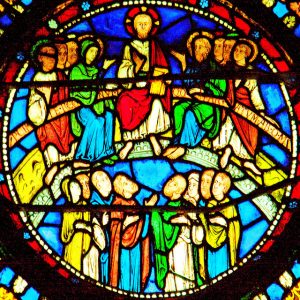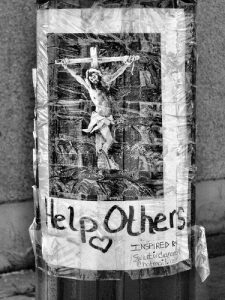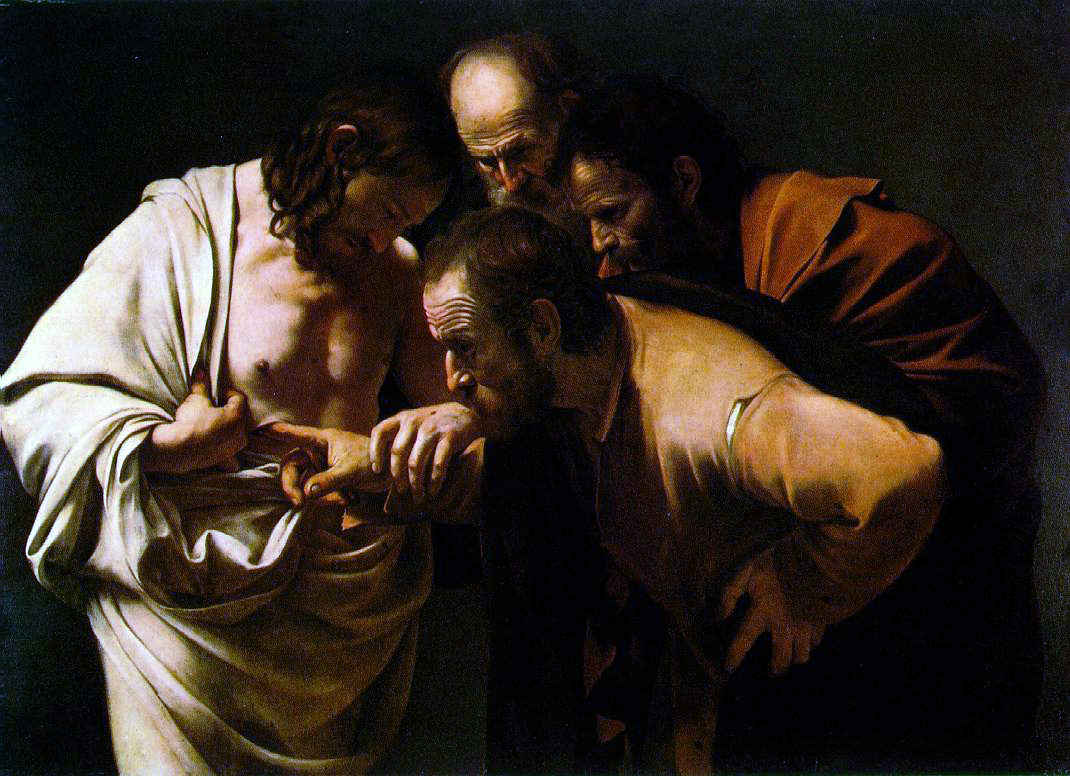Revised Common Lectionary Reflection for the Second Sunday of Easter, Year A
Lessons: Acts 2:14a, 22-32, Psalm 16, 1 Peter 1:3-9, John 20:19-31
Theme: God’s faithful and generous people are called to the dual and intertwined roles of steward and evangelist. We are entrusted with this very good gospel and a fine example in Thomas.
Key Scripture: Then Jesus said to Thomas, “Put your finger here and see my hands. Reach out your hand and put it in my side. Do not doubt but believe.” Thomas answered him, “My Lord and my God!” Jesus said to him, “Have you believed because you have seen me? Blessed are those who have not seen and yet have come to believe.” — John 20:27-29
Preaching/Teaching Reflection
Poor Thomas! He’s suffered over the years from a tarnished reputation caused by an inept translation of the word apistos. Instead of “doubting” Thomas, he was more like “unbelieving” Thomas. In short, Thomas was simply human and in need of real proof. He wasn’t there when Jesus first came to the disciples, but they told him how Jesus had come through a locked door, showed the scars of his crucifixion, and then breathed on the disciples imparting the gift of the Holy Spirit. To Thomas, this was logically impossible. He needed to see Jesus. He needed Jesus to meet him in his unbelief.
You know the rest of the story. A week later Jesus appears behind the closed doors and provides Thomas with  the “living proof” he needs to move from unbelief to belief, from skepticism to surety. His confession of faith is simple and profound: “My Lord and my God!”
the “living proof” he needs to move from unbelief to belief, from skepticism to surety. His confession of faith is simple and profound: “My Lord and my God!”
So how is this story from John’s gospel an evangelism lesson? Simple–Thomas’ need to see in order to believe is pretty much like most folks we encounter who are not immersed in “church culture.” Think about it for a minute. If you grew up in Sunday school, attended church camps and Vacation Bible School, and knew the story of Jesus inside/out, the Jesus story probably makes sense to you. It is likely a part of your world view. You have seen and experienced Jesus in many different ways. But to most logical, rational non-church folks the Jesus story sounds not only pretty strange; it sounds pretty much impossible–the stuff of fairy tales and filmmakers. Believing in something or someone with all your heart, mind, and soul is pretty tough in our post-Christian “alternative facts”-beset culture.
It’s not always just non-churchy folks who have problems moving beyond unbelief. In a youth group I once worked with, a young teen who had been reared in the faith confided to me almost angrily, “How do you expect me to believe in something I can’t even see, much less touch? How do I know any of this is for real?” Even the most faithful among us can probably count moments of wavering doubt and uncertainty. Belief and unbelief season our lives as salt and pepper does our dinner, modifying the flavor of our faith accordingly.
Thomas gives us courage to admit and own those times when the saltiness of unbelief makes faith hard to stomach. His passionate witness upon seeing Jesus reminds us that God meets us where we need to be met, seasoning our life with a holy fire for living the good news in our daily lives. Thomas also reminds us that  people believe by seeing. That means we need to “show” them the gospel by living it out in our lives. We are called to be good stewards of this very good news.
people believe by seeing. That means we need to “show” them the gospel by living it out in our lives. We are called to be good stewards of this very good news.
Like Jesus inviting Thomas to reach out and touch his wounds, we must be willing to invite people into our lives. What they know of Jesus may be only what they see in those who call themselves “Christians.” That means we have both great opportunity and great responsibility. Evangelism should not be some complicated program or elaborate scheme. It’s not even about filling our pews, committee rosters, and offering plates. It is first and foremost about inviting others to experience the radical grace of our Lord Jesus Christ so that they, too, can proclaim with certainty “My Lord and my God.”
May this Easter season provide you with new opportunities to show and tell the story of Jesus the Christ, and may resurrection be evident in your every breath and action. Alleluia! Christ is risen! Lord, like you did with Thomas, move us beyond unbelief.
In Worship
Helping people to see both the unique cut and fit of their faith and the corporate nature of being “cut from the same cloth” requires creativity and out-of-the-box thinking. Consider inviting worshipers to think of their favorite article of clothing. Maybe it’s a dress that was made of really fine material and that fit like a glove. Perhaps it is a faded denim jacket that’s been around for a quarter century. It might be a Harris Tweed sports jacket that’s been handed down from father to son. Then invite them to share the story of that item with someone sitting close to them–to tell the story of why they love this article of clothing so and why it is their very favorite. Now make the case for a faith that’s as comfortable as those jeans, or as perfect a fit as that dress, or as meaningful and well-loved as that hand-me-down sports jacket. Can they share the story of their faith as easily as the story of an article of clothing? What does a life dressed in Christ really look like? Hopefully it isn’t like some one-size-fits-most caftan or rain poncho that doesn’t really fit anyone well. When we are clothed in Christ, we are truly wearing the very best, and we are both alike and unique in how we model and share our Christian identity.
With Youth
What does it mean to be a witness? If one is called to court to testify as a witness to a crime, one swears to “tell the whole truth, so help me God.” If one witnesses a monumental sporting event, like a play-off game’s come-from-behind win, one has the sense of truly having been a part of something special. If one witnesses an automobile accident, one has the obligation to recount what happened when the police come. So just what does it mean for us to bear witness to the good news of Jesus Christ? We weren’t actually there to see any of it. We don’t have pictures or video. In this week’s gospel lesson Thomas misses Jesus’ first visit to the room where the disciples are hiding, and he says he won’t believe until he can see and even touch Jesus’ wounds. Well, he gets just what he needs, and he does see Jesus and offers a bold and simple confession: “My Lord and my God!”
Instead of eyewitnesses, we are called to be heart and faith witnesses. We believe that even our belief is a gracious gift, and in this believing we have real, abundant life in Christ’s name. We can share the story, but we need to help people come and see so that they can experience faith for themselves. By seeing Christ in us and in our lives, all have the opportunity to come to know the Lord of the Universe.
With Children
The Path of Life
In today’s psalm, the poet concludes, “You show me the path of life. In your presence there is fullness of joy; in your right had are pleasures forevermore.” We all need to be shown the right way to go. The “old school” way was to stop and ask folks, who would then give you directions using landmarks. Another way is to have someone draw you a map or to use a purchased map. Other ways include relying on the stars at night or a compass. Now we often depend on directions from the Internet or from our GPS devices. Our phones even give us voice-command instructions. All of these different ways can help us get to our destination.
Give the children paper and crayons and ask them to draw you a map to help you get to a destination on the church property. Maybe it’s your car in the parking lot, your office, or the church kitchen. Chances are that all the maps will look a little bit different, but they’ll all be pointing you to the same place.
God is the one who shows us how to live a really amazing life. But God uses others to help guide us. We use scripture. We have pastors and teachers and parents to guide us. We have examples of faithful Christians and their witness to guide us. And we have prayer, Word, and the Sacraments. All of these tools point to God, the one who ultimately gives us life and guides us to joyful abundance. End with a simple prayer for God to help the children stay on the path of life in Christ.
Weekly Stewardship Bulletin Insert
The story of Thomas and his doubting or unbelief (better translation) also has a lot to do with both evangelism and stewardship. Thomas had a need to see Jesus, and Jesus met that need. Thomas was then able to proclaim the good news and steward the story. How has Jesus met you at your place of deepest need? Are you ready to be a good steward and share that story with others?
Stewardship at Home
Take time during these 50 days to reflect on the peace of Christ and how Jesus breathes the Holy Spirit into those early disciples. The Holy Spirit is a gift to us in baptism—a gift that keeps on giving and journeying with us. Quiet time to reflect helps us listen for the Spirit’s nudging. Consider viewing this lovely and meditative YouTube video of “Spiritus Sanctus” composed by Hildegard of Bingen. You’ll also enjoy the stunning nature photography.
Photos: Doubting Thomas, painting by Caravaggio and Mark Morgan, Creative Commons. Thanks!
Note: Reprint rights granted to congregations and other church organizations for local, nonprofit use. Just include this note: “Copyright (c) 2017, Rev. Sharron Blezard. Used by Permission.” Other uses, please inquire: thewritelife@hotmail.com.




Leave a Reply